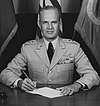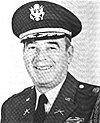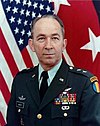United States Army Aviation Center of Excellence
This article has multiple issues. Please help or discuss these issues on the talk page. (Learn how and when to remove these template messages)
|
| U.S. Army Aviation Center of Excellence | |
|---|---|
 | |
| Active | 2006- |
| Country | United States |
| Role | Training and Development |
| Garrison/HQ | Fort Rucker, Alabama |
The U.S. Army Aviation Center of Excellence, formerly known as the Army Aviation Center and School, is the United States Army Aviation Branch's training and development center, located at Fort Rucker, Alabama. It "trains military, civilian, and international personnel in leadership skills and integrates aviation war fighting doctrine and requirements determination across the DOTMLPF".[1] Its Commanding General is Major General David J. Francis.[2]
The Center of Excellence includes three aviation brigades, the 1st Aviation Brigade, 110th Aviation Brigade, and 128th Aviation Brigade, and a Non-commissioned Officers' Academy.
History[]

Most training of pilots and mechanics for World War II Army Aviators was conducted by the Department of Air Training within the Field Artillery School at Henry Post Army Airfield, Okla., although the Army Air Forces conducted some primary training of Army Aviation personnel. In early 1953 and during the Korean War, the Department of Air Training at Post Field expanded, and became the Army Aviation School. As a result of the expansion of both aviation and artillery training, Post Field became overcrowded, and the Army decided to move the Army Aviation School to a different post. When no satisfactory permanent Army post was found, Camp Rucker was chosen as a temporary post. The Army Aviation School began moving to Alabama in August 1954 and the first class began at Rucker in October.
On February 1, 1955, the Army Aviation Center was officially established at Rucker. In the same year during the month of October, the post was given a permanent status with the change of name from Camp Rucker to Fort Rucker. Before the mid-1950s, the Air Force had provided primary training for Army Aviation pilots and mechanics. In 1956, the U.S. Department of Defense gave the Army control over all of its own training. Gary and Wolters Air Force Bases in Texas, where the Air Force had been conducting this training, were also transferred to the Army. Lacking adequate facilities at Fort Rucker, Army Aviation continued primary fixed-wing training at Camp Gary until 1959 and primary rotary-wing training at Fort Wolters until 1973.
The pioneer African American flying instructor Milton Crenchaw taught at then-Camp Rucker from 1954 to 1966.
In 1956, the Army Aviation Center began assembling and testing weapons on helicopters. These tests were conducted while the Air Force still theoretically had exclusive responsibility for aerial fire support This led to the development of armament systems for Army helicopters.
The 2005 Base Realignment and Closure Commission proposed that Aviation logistics establishments at Fort Eustis be consolidated with the Aviation Center and School at Fort Rucker, although this did not take place. What had become the U.S. Army Aviation War fighting Center was eventually renamed the U.S. Army Aviation Center of Excellence on 26 June 2006.
Command and Directorates[]
The 1st Aviation Brigade is based here.
The Unmanned Aerial Systems Center of Excellence (UAS CoE), as the U.S. Army UAS Proponent's principle management agency, provides intensive, centralized total capacity management and Unmanned Aerial System integration.
The UAS CoE mission statement is to provide, "integration and coordination with all Army organizations, the joint services, and other Defense Department agencies to achieve the U.S. Army UAS strategy that includes concepts for current, emerging and future UAS interoperability with all manned and unmanned systems".[3]
The 110th Aviation Brigade consists of four battalions using three different sites. 1st Battalion, 11th Aviation Regiment, operates and manages air traffic control services for USAACe/Fort Rucker and the National Airspace System. 1st Battalion, 14th Aviation Regiment operates from Hanchey Army Heliport and conducts graduate level training using the AH-64 Apache attack helicopter. 1st Battalion, 212th Aviation Regiment operates from Lowe Army Heliport and Shell Army Heliport and conducts combat and night operational training, using OH-58 Kiowa, UH-1 Iroquois, and UH-60 Blackhawk helicopters. 1st Battalion, 223d Aviation Regiment operates from Cairns Army Airfield and Knox Army Heliport and conducts flight training using the CH-47 Chinook helicopter and C-12 Huron aircraft.
Training[]
At the Center students learn to fly and also to employ aviation assets to assist United States forces with the 110th Aviation Brigade. Students usually spend 15–18 months in the aviation school, learning a wide range of subjects, and finally graduating with their "wings" or Aviator's Badge. When second lieutenants arrive at Fort Rucker after graduating from their commissioning source (USMA, ROTC or OCS) they secure housing, they attend the two-month Basic Officer Leadership Course (BOLC) at Fort Rucker. Upon completion, they join the rest of their classmates, usually Junior Warrant Officers, many of whom have previous enlisted experience.
Before starting academics, students must complete Dunker training and Army SERE (Survival, Evasion, Resistance and Escape) school. After SERE, students transition to Initial Entry Rotary Wing Aeromedical Training (also known as "aeromed") at the , where they learn subjects pertaining to flight and the human body. The information taught in these classes is tested frequently by the instructor pilots (IPs) throughout flight school. Flight training varies by student and aircraft type, but in general students will complete Basic Flight training, Instrument flight training and basic combat skills training. Students are taught the fundamentals of flight as well as instrument flight in a TH-67 Bell Jetranger aircraft. Basic Combat skills training is taught in an OH-58.
List of commanding generals[]
| No. | Commanding General | Term | |||
|---|---|---|---|---|---|
| Portrait | Name | Took office | Left office | Duration | |
| 1 | Brigadier General (1906–1966) | February 1, 1955 | June 1957 | ~2 years, 134 days | |
| 2 | Major General Bogardus S. Cairns (1910–1958) | June 1957 | December 9, 1958 † | ~1 year, 176 days | |
| – | Colonel (1907–1974) Acting | December 9, 1958[4] | February 16, 1959 | 69 days | |
| 3 | Major General (1908–1989) | February 16, 1959 | March 1962 | ~3 years, 27 days | |
| 4 | Brigadier General (1918–2009) | March 1962 | August 1963 | ~1 year, 152 days | |
| 5 | Major General (1915–2014) | August 1963 | February 28, 1965 | ~1 year, 196 days | |
| 6 | Major General John J. Tolson III (1915–1991) | March 1, 1965 | March 1967 | ~2 years, 0 days | |
| 7 | Major General Delk M. Oden (1911–1997) | March 1967 | September 1970 | ~3 years, 197 days | |
| 8 | Major General Allen M. Burdett Jr. (1921–1980) | September 1970 | August 31, 1973 | ~2 years, 349 days | |
| 9 | Major General William J. Maddox Jr. (1921–2001) | September 1, 1973 | June 30, 1976 | 2 years, 303 days | |
| 10 | Major General James C. Smith (1923–2016) | July 1, 1976 | December 1978 | ~2 years, 167 days | |
| 11 | Major General (1929–2003) | December 1978 | July 28, 1980 | ~1 year, 225 days | |
| 12 | Major General (born 1933) | July 28, 1980 | June 1983 | ~2 years, 322 days | |
| 13 | Major General (born 1936) | June 1983 | January 1985 | ~1 year, 213 days | |
| 14 | Major General Ellis D. Parker (1932–2020) | January 1985 | September 1989 | ~4 years, 242 days | |
| 15 | Major General (born 1941) | September 1989 | July 22, 1991 | ~1 year, 309 days | |
| 16 | Major General (born 1937) | July 22, 1991 | July 28, 1994 | 3 years, 6 days | |
| 17 | Major General Ronald E. Adams (born 1943) | July 28, 1994 | September 12, 1996 | 2 years, 46 days | |
| 18 | Major General (born 1944) | September 12, 1996 | September 23, 1998 | 2 years, 11 days | |
| 19 | Major General Anthony R. Jones (born 1948) | September 23, 1998 | August 9, 2001 | 2 years, 320 days | |
| 20 | Major General (born 1952) | August 9, 2001 | December 10, 2003 | 2 years, 123 days | |
| 21 | Brigadier General (born 1954) | December 10, 2003 | June 29, 2006 | 2 years, 201 days | |
| 22 | Major General | June 29, 2006 | July 11, 2008 | 2 years, 12 days | |
| 23 | Major General | July 11, 2008[5] | August 19, 2010 | 2 years, 39 days | |
| 24 | Major General Anthony G. Crutchfield (born 1960) | August 19, 2010[6] | August 10, 2012 | 1 year, 357 days | |
| 25 | Major General Kevin W. Mangum (born 1960) | August 10, 2012[7] | March 20, 2014 | 1 year, 222 days | |
| 26 | Major General Michael D. Lundy | March 20, 2014[7] | April 6, 2016 | 2 years, 17 days | |
| 27 | Major General William K. Gayler | April 6, 2016[8] | June 17, 2019 | 3 years, 72 days | |
| 28 | Major General | June 17, 2019[9] | Incumbent | 2 years, 269 days | |
References[]
- ^ "Fort Rucker". Retrieved 8 February 2019.
- ^ "Commanding General USAACE and Fort Rucker" Retrieved on 7 July 2019.
- ^ "U.S. Army Aviation Center of Excellence and Fort Rucker: The Home of Army Aviation" (PDF). Archived from the original (PDF) on 16 February 2010. Retrieved 12 March 2010.
- ^ "Major General Bogardus S. Cairns" (PDF). Army Aviation. December 1958. p. 8. Retrieved 28 September 2021.
- ^ "Aviation Branch welcomes Barclay". www.army.mil.
- ^ "Crutchfield assumes command of USAACE, Fort Rucker". www.army.mil.
- ^ a b "New command team assumes lead of Aviation, USAACE, Fort Rucker". www.army.mil.
- ^ jmurray@southeastsun.com, Jan Murray. "Gayler takes reins at USAACE and Fort Rucker". The Southeast Sun.
- ^ "Francis takes command of USAACE, Fort Rucker". www.army.mil.
Further reading[]
- Lieutenant General John J. Tolson, Vietnam Studies: Airmobility 1961-1971, Department of the Army, WASHINGTON, D. C., 1973 (re-released 1989), Library of Congress Catalog Card Number 72-600371, First Printed 1973-CMH Pub 90-4
External links[]
- United States Army aviation
- Aviation schools in the United States
- United States Army schools






























